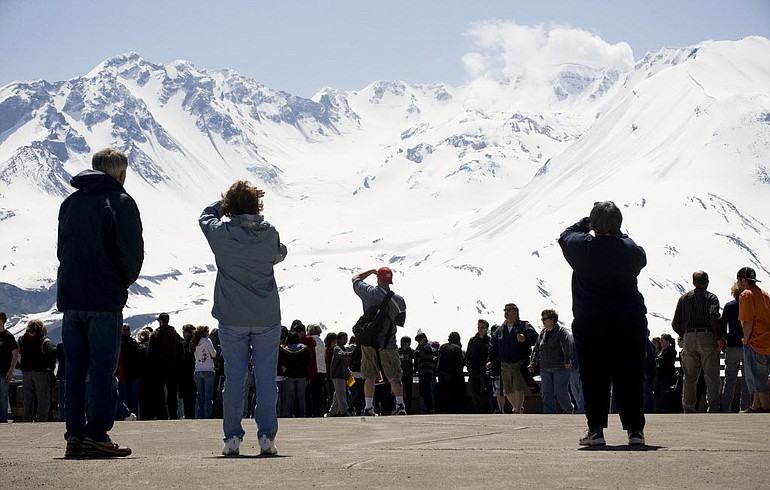Rediscovered photos show path of ash cloud
Online special section about Mount St. Helens
JOHNSTON RIDGE — The clouds parted, the sun came out, and hundreds of people took advantage of free admission Wednesday to visit Johnston Ridge Observatory on the 31st anniversary of the cataclysmic 1980 eruption of Mount St. Helens.
Highway 504 to the monument was plowed and clear, the observatory itself sported new windows, doors and carpeting, and three consoles installed last week offered new interactive touch-screen displays showing the return of life to the mountain over the past three decades.
But the real show was outdoors, where a crowd gathered to take in the stunning close-up view of the volcano’s snowy crater — just three miles away — as Forest Service interpretive guide Todd Cullings described the forces that created the alien landscape spread out before them.
Lori and Tony Martin of Portland were having a “staycation” when they decided to make the drive to the mountain Wednesday morning. “It was free, it was the anniversary, it just seemed like we were meant to come up here,” Tony Martin said. “It kind of makes you feel guilty” not to have visited one of the Northwest’s premier natural wonders, he added.
A group of geology and biology students from Albion College in Michigan were touring the state for a week with their professor and lucked out with perfect weather on the day they’d picked to visit the volcano.
Asked what surprised her most, Lannis Smith, a biology major, said, “It’s ginormous!” — much bigger than the images of the volcano she’d studied before the trip.
At a brief ceremony in the observatory’s refurbished theater, Forest Service and U.S. Geological Survey officials remembered the 57 people who died May 18, 1980, as the volcano unleashed its fury.
Tom Mulder, Forest Service manager of the Mount St. Helens National Volcanic Monument, described the investments the agency has made — some $14 million, most of it from federal stimulus dollars and private grants — to refurbish monument facilities over the past three years. The agency is still looking for a vendor to provide food services and a retail outlet at Coldwater Visitor Center, which was closed due to lack of funding a few years back and is now undergoing renovation.
Mulder described the trails and features available elsewhere around the monument, including at Windy Ridge, “a two-hour walk or a three-hour drive” from Johnston Ridge on the northeast side of the mountain. At Windy Ridge, the ghost forest of trees killed in the blast is evident, and a short trail leads to Spirit Lake, with its thick mat of trees killed in the blast. Forest Service roads to Windy Ridge may not open until July due to this year’s heavy snowpack, he said.
Cowlitz County Commissioner George Raiter was mayor of Longview in 1981. He recalled “scary times” in the years immediately after the eruption, when communities downstream in the Toutle River drainage feared that a temporary dam holding back Spirit Lake could break and unleash devastating floods.
The 1980 eruption provided a wealth of information for vulcanologists all over the world but was “a costly event” for the region, said John Ewert, managing scientist at the U.S. Geological Survey’s Cascades Volcano Observatory. Among those who died was David Johnston, the USGS geologist for whom the ridge and the visitor center are named, and the eruption and its aftermath resulted in well over $1 billion in economic losses, he said.
Scientists have learned lessons from the mountain about how volcanoes work and how to reduce hazards to life and property, Ewert said, and the lessons they’ve learned have saved lives.
Kent Connaughton, the Forest Service’s new Northwest regional forester, made his first trip to Johnston Ridge for Wednesday’s ceremony. He said the visit stirred strong emotions as he remembered the loss of life.
Connaughton recalled picking huckleberries in view of the volcano in the fall of 1980 and looking up at the black, shattered peak that had replaced the benign, symmetrical St. Helens he remembered.
“It was evil in its appearance,” he said. “It has transformed itself, not only environmentally but socially as well.”
A small group of activists who believe the monument should be turned over to the National Park Service to manage, with more trails, campgrounds, interpretive signs and overnight lodging, held a rally Wednesday afternoon to argue their case.
Mark Smith, owner of Eco Park Resort, a small private resort that provides the only overnight accommodation near the mountain, said in an interview Tuesday with The Columbian that the Forest Service lacks the vision to accomplish that.
Smith was a member of a commission that met for two years to discuss the future of the monument. He was one of two dissenters from the panel’s conclusion that the monument should remain under Forest Service management but with increased funding to promote visitor use and improve amenities.
“I think it’s pretty clear … that Mount St. Helens does not get a steady stream of funding, nor is it managed by the Forest Service under a model that promotes user visitation,” he said. “National parks, all of them, promote overnight accommodation and communing with nature. People can actually go out and hike and fish in a national park.” But at Mount St. Helens, he said, camping on trails is prohibited and the average day hike is 7.5 miles long, too far for many visitors.
“Everything has returned to the mountain except humans,” he said. “The whole model of the mountain needs to be revisioned. It was done in a different time for a different reason.”



